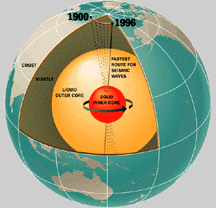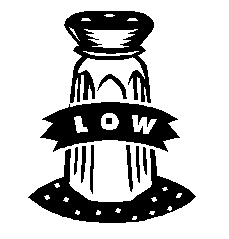THIRD
FROM THE SUN |
|
Third from the sun,
that's where we are
Not too close - and not too far
A planet of life to care for and nurture
So life will continue far into the future

| Mouseover images for messages. Click on linked underlined text for more information. | ||||||
|
Earth is
the third planet from the Sun and the fifth largest.
New discovery in our Solar System!
Notice the |
||||||
|
|
|||||
|
||||||
|
On a hot afternoon, the atmosphere draws up |
||||||
"The amount of sunshine energy that hits the surface of the Earth
every minute is greater than the total amount of energy that the world's
human population consumes in a year!"
"Like all stars, the sun is a huge fusion reactor, pumping out 100 million times as much energy in a single second as the entire population of Earth uses in a year!"
The Sun Runs on Fusion Energy - From Core to Corona
|
||||||
Do
you know why ocean water levels are higher Nope! And
the answer is . . .
|
|
|||||||
|
Did you guess a tall skyscraper or a
battleship? No, it is a coral reef - Australia's Great Barrier Reef, which is 1,250
miles long (that is as long as half-way across the United States). A coral reef is
made up of the hardened skeletons of tiny coral animals called polyps
(related to the jellyfish), and billions of living polyps of many beautiful colors.
Coral reefs are very important to sealife, providing shelter and food for hundreds of
species of living coral animals, many birds, over 1,000 species of fish, mollusks (such as
clams and mussels), and crustaceans (such as crabs), and other sealife.
Reefs are formed mostly in warm waters and where sunlight can penetrate.
Barrier reefs help protect shorelines from sea wave damage by providing a barrier.
Coral reefs are being damaged and dying from harmful human activities. The deteriorating condition of coral reefs is causing great
environmental concern. Protection is being provided to try and bring life back to
the reefs. |
|||||||
|
|||||||
|
Algae.
There are more than 25,000 species of algae, all of which contain
chlorophyll. |
|||||||
(such as toothpaste)
|
|||||||
Did you know that one of your favorite foods is probably Kelp seaweed with chocolate sauce on it?
You don't believe it? If you look up "seaweed" in your encyclopedia, it will tell you that Kelp is full of vitamins and minerals, but its primary value is as a source of algin, which is used to thicken ice cream and other products. You do like chocolate sauce on your ice cream, don't you?
|
|||||||
|
We need to come up for air after that one! Speaking
of air -
4.5 billion years ago when Earth was born,
Then about 3.5
billion years ago a bacteria, known as cyanobacteria, evolved which became quite widespread by the
Proterozoic period (544 million to 2.5 billion years ago). |
|||||||
How thick is the layer of Earth's atmosphere? |
|||||||
Earth
adapting to humans! |
|||||||
|
|||||||
|
What happened on December 26, 2004 that changed the shape of our planet? |
|||||||
 |
BELCHING BOVINES
A global menace !
|
||||||
|
|||||||
|
|||||||
|
Humans are moving the Earth! |
|||||||
| So many canals, dams and reservoirs have been constructed over the last 100 years that this redistribution of freshwater from one place to another has resulted in a small change in the wobble of the Earth as it spins. (Scientific American - Safeguarding our Water) | |||||||
Burning a 100 watt light bulb for one hour, with electricity that came from burning fossil fuels, causes 0.1 kilogram of carbon dioxide to be released into the atmosphere. |
|||||||
|
|||||||
So remember to turn the lights out
when you are not needing them
|
|||||||
WETLANDS Swamps, bogs, fens and marshes are
wetlands How should wetlands be changed to make them more useful?
|
|||||||
| Did "yew" know that clear-cutting loggers used to trash the Pacific Yew trees in the old-growth forests of the Pacific Northwest? | |||||||
| They considered them worthless - until scientists discovered that Taxol in the bark of the Pacific Yew was effective in containing growth of cancer cells. | |||||||
|
Taxol and the Pacific Yew tree have saved many lives since then. |
|||||||
| Just think...these trees were once wasted. What if they had become extinct before discovering their importance in medicine? | |||||||
| Imagine all the things we will never discover because so many plants, trees, organisms and animals are becoming extinct every day somewhere in the world. | |||||||
LIVING ICE CUBES! When winter comes in the northern
zones, the hibernators can't turn up the heat Some freeze "as hard as hockey pucks." Do you think any living
thing can survive as an ice cube? Imagine a species
that can freeze "solid as a rock" for months, |
|||||||
|
The Earth is
8,000 miles in diameter as it orbits At
these speeds, why don't we fly off the Earth into space? At the center of the
Earth is a giant rotating iron ball
|
|||||||
What does a submarine have in common with a seashell? |
|||||||
|
The Chambered Nautilus has a spiral shell which is divided into chambers, each one larger than the one before. The nautilus (soft-bodied mollusk) that lives inside fills the chambers with gases to rise in the water and reabsorbs the gases to sink. A submarine has compartments (tanks) which are filled with water to dive, and emptied of water to rise. The first nuclear-powered submarine was named "Nautilus" and was the first submarine to sail under the ice at the North Pole (1958). Submarines are used to explore the ocean and do scientific research. |
|||||||
| ssss | |||||||
|
HERE ARE A FEW EXTREMES OF LIFE ON OUR PLANET
There is a bloom that has been known to grow When certain conditions
exist and an overabundance of nutrients or pollution exist in water, such
as in lakes, estuaries and the ocean, an outbreak of plant growth can
occur known as an algae bloom. The largest one ever measured
occurred in the Gulf of Mexico, near the mouth of the Mississippi
River. Algae blooms can cause major environmental damage and kill
great numbers of fish. Read more about it on our Oceans page.
What's all the flap about? |
|||||||
|
The Bee
Hummingbird is the smallest of all birds Hummingbirds can hover and fly straight
up like helicopters |
|||||||
|
An Extremely
Long Nap! |
|||||||
|
An
Extremely Large Species
? |
|||||||
|
GIANT SQUID
First-ever observations of a live giant squid in the wild |
|||||||
You don't have to be big to be important
|
|||||||
|
Have you tired of your fish hobby, your pet turtle or frog, and the plants that you had growing in their little habitats within your home? Or do you feel sorry for them and want them to be free and returned to nature? How about your pet gorilla - has he gotten too big and now he's taking over? You think you'll be doing them a favor by setting them free?
Learn how invasive non-native species can harm the environment. Also, your pet may not live through the day once released into what might be an inhospitable environment for that species. Find out more: |
|||||||
|
What sea creature has a donut-shaped brain
Did
you know that the ocean waters are less salty near the
equator? Dive into our Ocean page and And be sure and visit Coral Communities, Wetlands and WaterWebs |
|||||||





Transp.gif)







